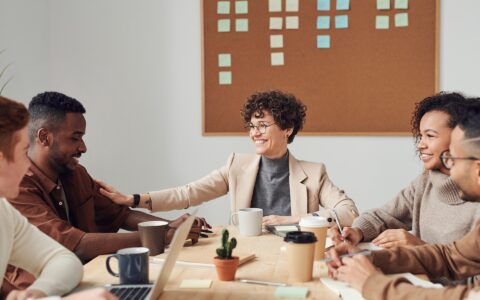Mastering Brainstorming Techniques: Learn How to Run a Brainstorming Session
Are you seeking innovative solutions, planning to introduce new services or products, or looking to engage your customers in exciting outdoor activities? If so, it's time to organize a brainstorming session. Brainstorming brings together diverse perspectives, enabling your team to explore ideas and gain deeper insights. However, a successful session requires more than just spontaneity. In this article, we'll explore the key principles and rules for conducting an effective brainstorming session.

Unleashing Creativity: The Essence of Brainstorming
A productive brainstorming session is not limited to a single solution. It aims to generate as many ideas as possible. It can be any member of your team who comes up with a solution to a problem. Therefore, the composition of a brainstorming session should be varied. Not only do you get many impartial opinions, but also a deep insight into the issue. Although spontaneity is one of the main characteristics of brainstorming, it does not mean that all brainstorming sessions will be a resounding success.
Manuals for managers are full of ideas on how to find solutions to problems in teams. You might try the ambassador method, which consists in splitting your team into two separate working groups. Another possibility is to distribute the necessary written materials to the team members and ask them to reflect on an issue overnight. Following the proverb 'The best advice is found on the pillow', you can go through their ideas the next day.
Creativity Knows No Bounds
A productive brainstorming meeting does not end with only one possible solution to a problem. It is the other way round, as its participants should try to come up with as many ideas as possible. Creativity knows no bounds but keep on mind that every brainstorming session should have some rules.
These rules serve to foster collaboration, define interactions, and create a supportive environment. Interestingly, breakthrough ideas sometimes emerge when participants unintentionally or intentionally break these rules. Remember, to break the rules, one must first know them.

10 Rules for a Successful Brainstorming Session
The following recommendations will help you achieve desirable outcomes in a brainstorming session:
1. Set expectations
Think about the expected result of a brainstorming meeting. Gather all the necessary documents and analyses and try to introduce a sample solution to your problem, or take some time to find out what your competitors did to foster a solution to a similar issue. Hand over all the information to the participants, preferably in advance.
2. Appoint a leader
His task is not only to open the meeting, but also to provide its participants with necessary documents and explain the purpose of the session. He is responsible for the smooth flow of ideas, directs the discussion, and makes sure that the participants always discuss only one idea, so that each participant gets the possibility to express his opinion. Alternatively, a brainstorming session can take place at a round table, and the leader gives the word to individual participants. Everyone should be given the opportunity to present at least one idea.
3. Consider the Composition
Think about the composition of the session. Who of your employees will participate, and why? Make sure that all participants know each other and know their position in the company. Before the beginning of the meeting, all participants should know the reason for their attendance and your expectations.
4. Designate a fast reporter
Choose a fast reporter who can write down all the ideas.
5. Choose an inspiring location
Think about a nice place for your brainstorming session. You do not have to organize a meeting in a corporate boardroom, especially if the weather is nice. And thanks to today's mobile technologies, there are no technical limitations.

6. Prepare necessary materials
Prepare all necessary materials, such as a blackboard, notebooks, paper, pencils, screen, projector, laptop or tablet, but also snacks and plenty of hot coffee.
7. Embrace all ideas
There are no stupid ideas. Ever! It is a brainstorming session, not a strategic meeting that requires serious solutions. Brainstorming should be fun, and each participant should think of it as an entertaining way to generate new ideas.
8. Avoid criticism
Do not criticize others’ ideas. This is not a discussion, debate or presentation of one person who needs to prove his superiority over others. Moreover, if you evaluate or criticize an idea, it changes the direction and nature of the ongoing discussion, which kills the joy to engage in the session.
9. Amplify ideas collaboratively
Build on other people’s ideas. Often an idea suggested by one person can trigger a better idea suggested by someone else. The development of ideas is one of the basic principles of a successful brainstorming session.
10. Quantity counts
Forget the rule "quality over quantity." The more creative ideas your team generates the better. As a facilitator, you can even prepare a challenge for the participants to come up with as many ideas as possible and compare them to the last brainstorming session you conducted.
How to Pick the Best Idea?
A brainstorming session is just the beginning because it takes a long time to implement the selected ideas. You can use one of the following methods to process the best ideas generated during a session:
Voting
It is said that any team that commits to voting, admits that it has no intelligent member. However, voting is a perfect decision-making process, which might work for your team. Usually, it is used in one of the two following cases:
- The decision depends on subjective factors, typically if it is a matter of taste.
- The result of a brainstorming session will be the decision made by a majority of participants who can not agree on a specific output.
During the voting process, you can focus on specific ideas, the advantages and disadvantages of which had been discussed previously. Key employees, including members of management and representatives of the client, who did not attend the brainstorming session, can participate in the voting process.
Before the vote carefully discuss a list of proposed solutions.
Affinity diagram
An affinity diagram is an organized list of solutions generated from a brainstorming session. Thanks to this method, you can put together thematically related ideas, analyse them and reach a final decision.
The process allows team members to organize their ideas by category so that they know which thoughts need to be discussed in more detail.
Decision matrix
Focus on the pros and cons of each idea, its potential impact and profits. Score each idea and select the best solutions. Try to group individual ideas and get the highest number of points to create logical combinations of various factors generated during the brainstorming session.
Broader perspective
Evaluate the generated ideas based on how they correspond with the original brainstorming assignment. Think about what is needed for their realization and what information you need to do so. Consider the pros and cons of each option.
Feel free to write down your feelings you have about ideas presented. Go through all possible factors that come to your mind in connection with the brainstorming result. If you look at the proposed solutions from multiple angles, you get a broader perspective, and the decision-making process will be much easier.
Other Possible Evaluation Methods
The above-mentioned methods are not the only ones that help you reach the goal, which is to select the best ideas generated during a brainstorming meeting. You can work with the SWOT analysis, use the Five Whys method, or create a simple scheme which interconnects various causes and their consequences.
Conclusion
Organizing a successful brainstorming session is a catalyst for unlocking your team's creative potential. By adhering to established rules and employing effective evaluation techniques, you can harness the collective intelligence of your team and arrive at innovative solutions. Embrace the art of brainstorming, and watch your organization thrive in the face of challenges and opportunities.











